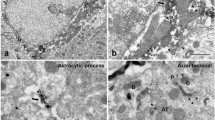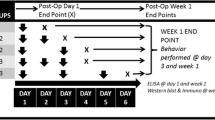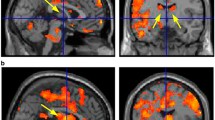Abstract
We have examined, by immunocytochemical methods and nociceptive behavior assessment in rats, whether astrocytes in the parabrachial nucleus (PBN) are involved in the regulation of traumatic occlusion. The expression of glial fibrillary acidic protein (GFAP) in PBN of ipsilateral and contralateral sides was up-regulated 4 h after occlusal changes in molars, reached peak levels at 24 h, and was then gradually down-regulated. PBN astrocytes activated by traumatic occlusion were found to have enlarged cell bodies and thickened processes within 8 h. An inhibitor of glia metabolism (FCA, fluorocitrate) reduced astrocyte activation and significantly attenuated the development of pain hypersensitivity in this model. The results suggested that the GFAP-immunoreactive astrocytes in PBN within the bridge of Varolius were activated by traumatic occlusion, and that they were involved in the transmission and modulation of nociceptive information in the central nervous system. However, although astrocytes in PBN are thus probably involved in causing post-occlusal hyperalgesia, we have not been able to exclude that astrocytes at other locations also contribute to this effect.



Similar content being viewed by others
References
Allen GV, Barbrick B, Esser MJ (1996) Trigeminal-parabrachial connections: possible pathway for nociception-induced cardiovascular reflex responses. Brain Res 715:125–135
Anderson LC, Rao RD (2001) Interleukin-6 and nerve growth factor levels in peripheral nerve and brainstem after trigeminal nerve injury in the rat. Arch Oral Biol 46:633–640
Araque A, Martin ED, Perea G, Arellano JI, Buno W (2002) Synaptically released acetylcholine evokes Ca2+ elevations in astrocytes in hippocampal slices. J Neurosci 22:2443–2450
Benarroch EE (2006) Pain-autonomic interactions. Neurol Sci 27(Suppl 2):S130–S133
Bernard JF, Besson JM (1990) The spino(trigemino)pontoamygdaloid pathway: electrophysiological evidence for an involvement in pain processes. J Neurophysiol 63:473–490
Bernard JF, Alden M, Besson JM (1993) The organization of the efferent projections from the pontine parabrachial area to the amygdaloid complex: a Phaseolus vulgaris leucoagglutinin (PHA-L) study in the rat. J Comp Neurol 329:201–229
Bester H, Menendez L, Besson JM, Bernard JF (1995) Spino (trigemino) parabrachiohypothalamic pathway: electrophysiological evidence for an involvement in pain processes. J Neurophysiol 73:568–585
Bourgeais L, Gauriau C, Monconduit L, Villanueva L, Bernard JF (2003) Dendritic domains of nociceptive-responsive parabrachial neurons match terminal fields of lamina I neurons in the rat. J Comp Neurol 464:238–256
Dallel R, Ricard O, Raboisson P (2004) Organization of parabrachial projections from the spinal trigeminal nucleus oralis: an anterograde tracing study in the rat. J Comp Neurol 470:181–191
Davar G, Hama A, Deykin A, Vos B, Maciewicz R (1991) MK-801 blocks the development of thermal hyperalgesia in a rat model of experimental painful neuropathy. Brain Res 553:327–330
Duffy S, MacVicar BA (1995) Adrenergic calcium signaling in astrocyte networks within the hippocampal slice. J Neurosci 15:5535–5550
Dupont JS (2006) Acute malocclusion. Gen Dent 54:102–104
Fellin T, Carmignoto G (2004) Neurone-to-astrocyte signalling in the brain represents a distinct multifunctional unit. J Physiol (Lond) 559:3–15
Ferreira SH, Nakamura M, Abreu Castro MS de (1978) The hyperalgesic effects of prostacyclin and prostaglandin E2. Prostaglandins 16:31–37
Fu K, Ma X, Zhang Z, Sun K, Wang J, Zhu X (1999) Ultrastructural changes of TMJ articular cartilage and synovial membrane following occlusal trauma in rabbit. Chin J Traumatol 2:105–109
Fujiyoshi Y, Yamashiro T, Deguchi T, Sugimoto T, Takano-Yamamoto T (2000) The difference in temporal distribution of c-Fos immunoreactive neurons between the medullary dorsal horn and the trigeminal subnucleus oralis in the rat following experimental tooth movement. Neurosci Lett 283:205–208
Green MS, Levine DF (1996) Occlusion and the periodontium: a review and rationale for treatment. J Calif Dent Assoc 24:19–27
Hallmon WW (2001) Occlusal trauma–periodontal concerns. Tex Dent J 118:956–960
Hayashi H, Tabata T (1990) Pulpal and cutaneous inputs to somatosensory neurons in the parabrachial area of the cat. Brain Res 511:177–179
Hiroshima K, Maeda T, Hanada K, Wakisaka S (2001) Temporal and spatial distribution of Fos protein in the parabrachial nucleus neurons during experimental tooth movement of the rat molar. Brain Res 908:161–173
Hu B, Chiang CY, Hu JW, Dostrovsky JO, Sessle BJ (2002) P2X receptors in trigeminal subnucleus caudalis modulate central sensitization in trigeminal subnucleus oralis. J Neurophysiol 88:1614–1624
Kang J, Jiang L, Goldman SA, Nedergaard M (1998) Astrocyte-mediated potentiation of inhibitory synaptic transmission. Nat Neurosci 1:683–692
Kato J, Wakisaka S, Tabata MJ, Sasaki Y, Kurisu K (1994) Induction of Fos protein in the rat trigeminal nucleus complex during an experimental tooth movement. Arch Oral Biol 39:723–726
Kawamoto S, Nagaoka E (2000) The effect of oestrogen deficiency on the alveolar bone resorption caused by traumatic occlusion. J Oral Rehabil 27:587–594
Kulik A, Haentzsch A, Luckermann M, Reichelt W, Ballanyi K (1999) Neuron-glia signaling via alpha (1) adrenoceptor-mediated Ca(2+) release in Bergmann glial cells in situ. J Neurosci 19:8401–8408
Kvinnsland I, Heyeraas KJ (1992) Effect of traumatic occlusion on CGRP and SP immunoreactive nerve fibre morphology in rat molar pulp and periodontium. Histochemistry 97:111–120
Kvinnsland S, Kristiansen AB, Kvinnsland I, Heyeraas KJ (1992) Effect of experimental traumatic occlusion on periodontal and pulpal blood flow. Acta Odontol Scand 50:211–219
Kvinnsland S, Kvinnsland I, Kristiansen AB (1993) Effect of experimental traumatic occlusion on blood flow in the temporomandibular joint of the rat. Acta Odontol Scand 51:293–298
Ledeboer A, Mahoney JH, Milligan ED, Martin D, Maier SF, Watkins LR (2006) Spinal cord glia and interleukin-1 do not appear to mediate persistent allodynia induced by intramuscular acidic saline in rats. J Pain 7:757–767
Magdalena CM, Navarro VP, Park DM, Stuani MB, Rocha MJ (2004) C-fos expression in rat brain nuclei following incisor tooth movement. J Dent Res 83:50–54
Meller ST, Dykstra C, Grzybycki D, Murphy S, Gebhart GF (1994) The possible role of glia in nociceptive processing and hyperalgesia in the spinal cord of the rat. Neuropharmacology 33:1471–1478
Pasti L, Volterra A, Pozzan T, Carmignoto G (1997) Intracellular calcium oscillations in astrocytes: a highly plastic, bidirectional form of communication between neurons and astrocytes in situ. J Neurosci 17:7817–7830
Porter JT, McCarthy KD (1996) Hippocampal astrocytes in situ respond to glutamate released from synaptic terminals. J Neurosci 16:5073–5081
Salter MW (2005) Cellular signalling pathways of spinal pain neuroplasticity as targets for analgesic development. Curr Top Med Chem 5:557–567
Saper CB (1995) The spinoparabrachial pathway: shedding new light on an old path. J Comp Neurol 353:477–479
Sodeyama T, Maeda T, Takano Y, Hara K (1996) Responses of periodontal nerve terminals to experimentally induced occlusal trauma in rat molars: an immunohistochemical study using PGP 9.5 antibody. J Periodontal Res 31:235–248
Storey E (1973) The nature of tooth movement. Am J Orthod 63:292–314
Swanson LW (1995) Mapping the human brain: past, present, and future. Trends Neurosci 18:471–474
Waldo CM (1953) Method for the study of tissue response to tooth movement. J Dent Res 32:690–691
Watkins LR, Maier SF (1999) Implications of immune-to-brain communication for sickness and pain. Proc Natl Acad Sci USA 96:7710–7713
Watkins LR, Maier SF (2003) Glia: a novel drug discovery target for clinical pain. Nat Rev Drug Discov 2:973–985
Watkins LR, Martin D, Ulrich P, Tracey KJ, Maier SF (1997) Evidence for the involvement of spinal cord glia in subcutaneous formalin induced hyperalgesia in the rat. Pain 71:225–235
Willoughby JO, Mackenzie L, Broberg M, Thoren AE, Medvedev A, Sims NR, Nilsson M (2003) Fluorocitrate-mediated astroglial dysfunction causes seizures. J Neurosci Res 74:160–166
Woda A, Molat JL, Luccarini P (2001) Low doses of N-methyl-D-aspartate antagonists in superficial laminae of medulla oblongata facilitate wind-up of convergent neurones. Neuroscience 107:317–327
Xie YF, Zhang S, Chiang CY, Hu JW, Dostrovsky JO, Sessle BJ (2006) Involvement of glia in central sensitization in trigeminal subnucleus caudalis (medullary dorsal horn). Brain Behav Immun [Epub ahead of print]
Yamashiro T, Satoh K, Nakagawa K, Moriyama H, Yagi T, Takada K (1998) Expression of Fos in the rat forebrain following experimental tooth movement. J Dent Res 77:1920–1925
Zhu ML, Liu HC, Hao ZQ, Duan LJ (2004) Expression of PN3 and NaN in trigeminal ganglion during occlusal trauma in rat. Zhonghua Kou Qiang Yi Xue Za Zhi 39:421–424
Acknowledgements
We thank Dr. Tracey Walmsley (UK) and Ms. Fan Peng (Fourth Military Medical University, Xi’an) for improving the English of the manuscript. We are also grateful to Xiao-Dong Liu, Jian-yong Qiu, Li Duan, Rong Cao, and Jin-jie Wang (Neuroscience Institute, Fourth Military Medical University, Xi’an) for their excellent technical assistance.
Author information
Authors and Affiliations
Corresponding author
Additional information
Jinwu Chen and Jun Zhang contributed equally to this study.
This study was supported by the National Nature Science Foundation of China (nos. 30400503 and 30572066).
Rights and permissions
About this article
Cite this article
Chen, J., Zhang, J., Zhao, Y. et al. Hyperalgesia in response to traumatic occlusion and GFAP expression in rat parabranchial nucleus: modulation with fluorocitrate. Cell Tissue Res 329, 231–237 (2007). https://doi.org/10.1007/s00441-007-0409-3
Received:
Accepted:
Published:
Issue Date:
DOI: https://doi.org/10.1007/s00441-007-0409-3




